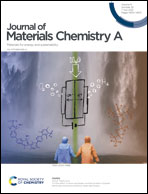A humidity sensing and respiratory monitoring system constructed from quartz crystal microbalance sensors based on a chitosan/polypyrrole composite film†
Abstract
In this work, a quartz crystal microbalance (QCM) humidity sensor based on a chitosan/polypyrrole (CS/PPy) composite film was prepared by a facile physical modification method. The as-synthesized CS/PPy composite was characterized using X-ray photoelectron spectroscopy (XPS), scanning electron microscopy (SEM), water contact angle test and Fourier transform infrared spectroscopy (FT-IR) to confirm its successful preparation. The experimental results showed that the CS/PPy QCM humidity sensor had high sensitivity, low hysteresis (1.68% RH), short response/recovery time (13 s/2 s), excellent selectivity, and good repeatability and stability. The overall frequency offset was −5132.12 Hz (0–97% RH). The mechanism of the enhanced humidity sensing performance was attributed to the hydrophilic groups and incomplete coating structure. In addition, the sensor could quickly and accurately sense changes in rate, depth, and rhythm of breathing. Furthermore, an app was designed to accurately determine the type of breathing and demonstrate the potential respiratory monitoring of patients.



 Please wait while we load your content...
Please wait while we load your content...